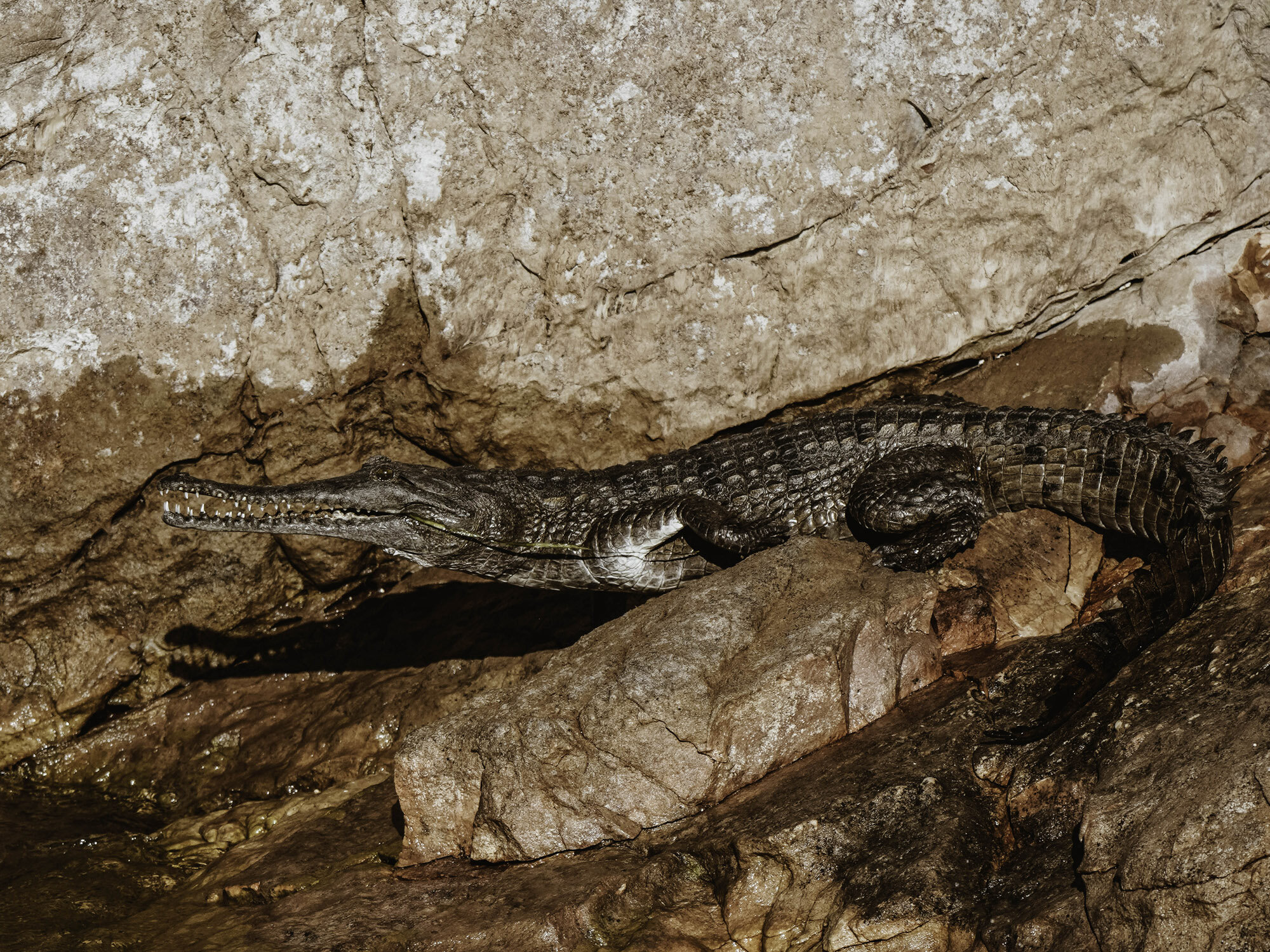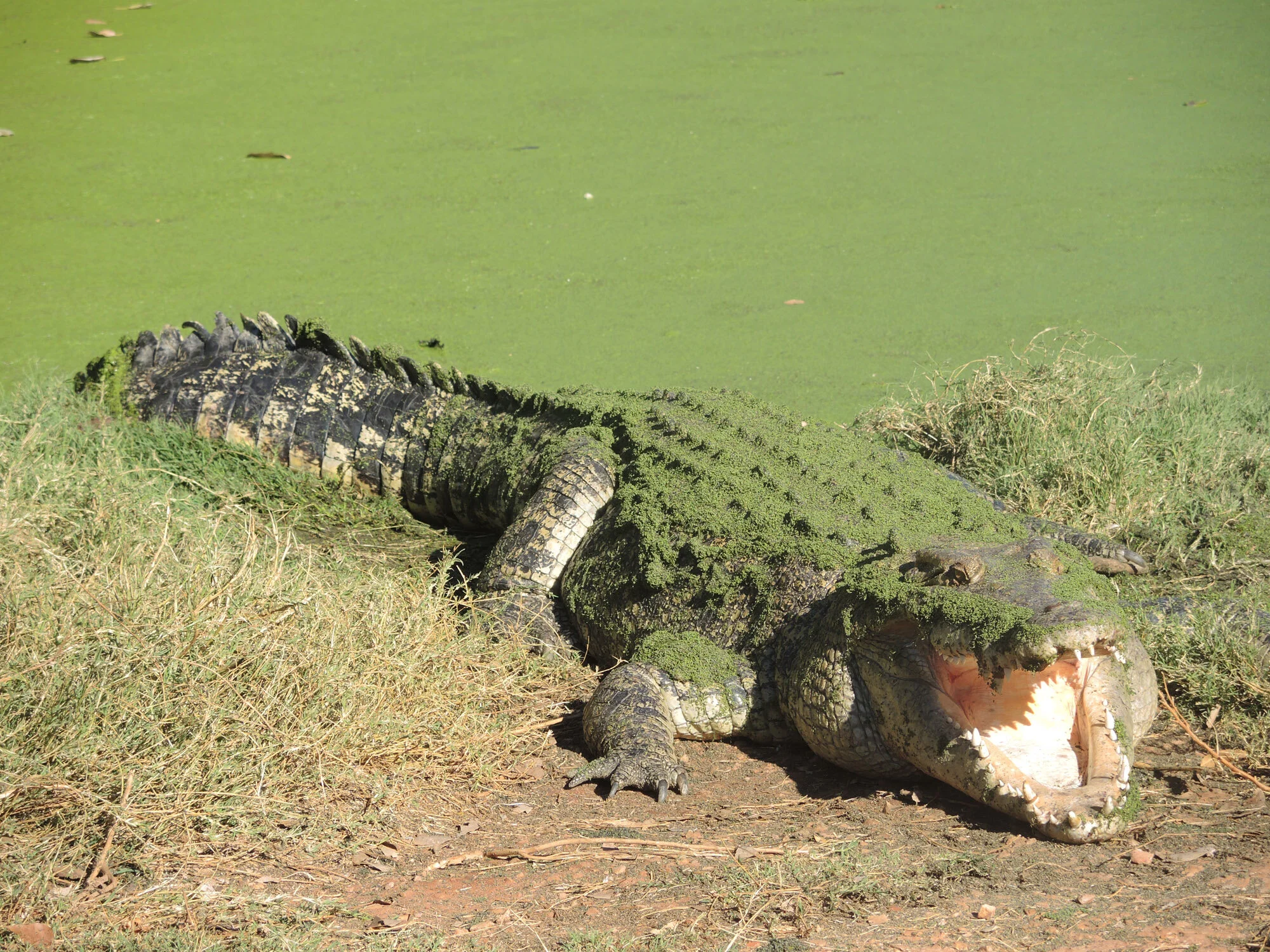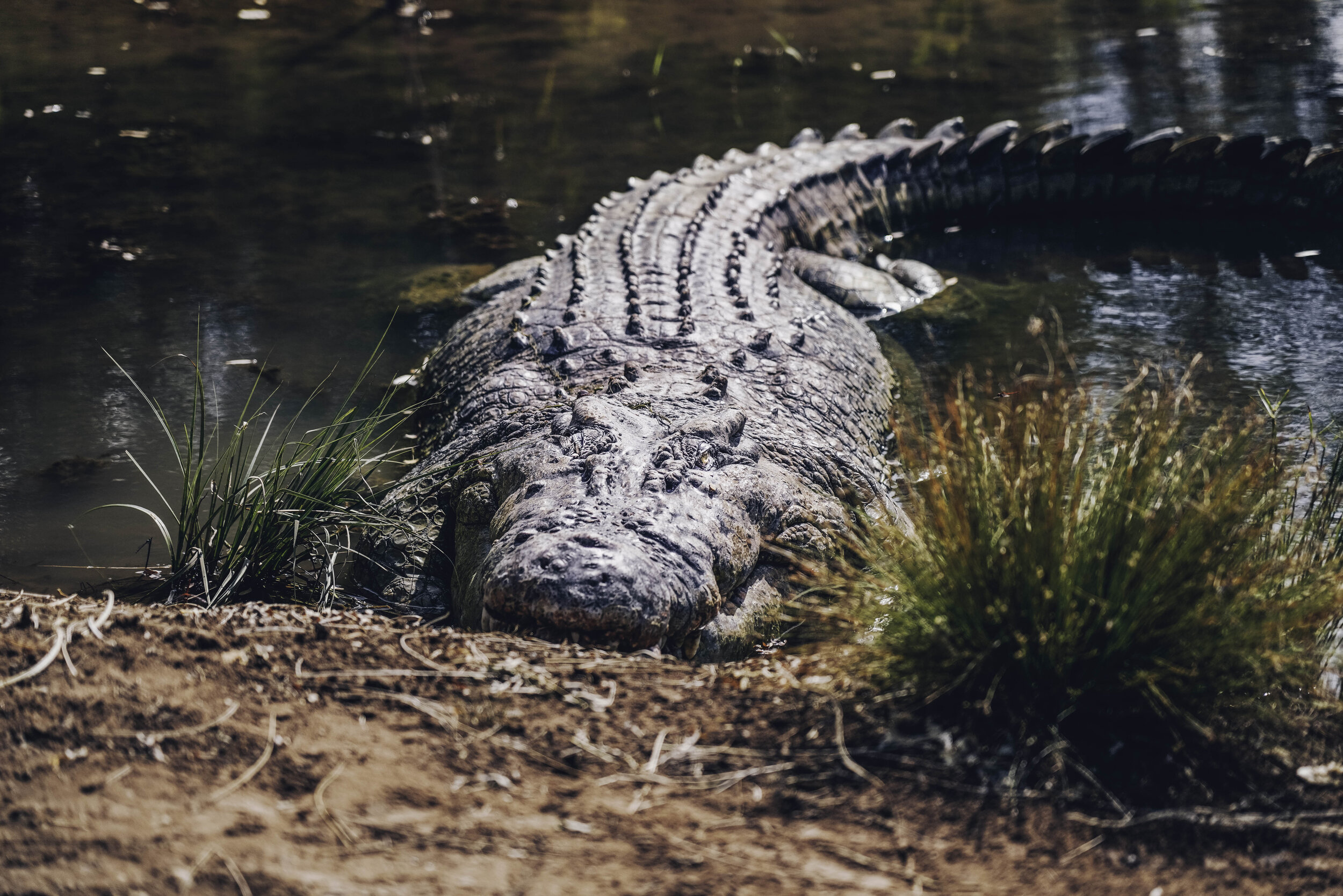Header image by Brinkley Davies.
Crocs can be difficult to see - they’re good at hiding. You need to know where to go and when. Here are our tips for croc spotting in the Kimberley. Remember, croc safety is paramount. You must never get in the water with a saltwater/estuarine croc. The Kimberley is not like the Territory - there are very few places with croc warning signs in the Kimberley. If unsure, always ask a local.
Freshie (freshwater croc). Image by Brinkley Davies.
Saltie (saltwater croc), image by M. Connell
spot the difference - freshie vs saltie
There’s a big difference between the 2 kinds of crocodiles that are found in the Kimberley’s waterways (freshwater ‘crocodylus johnstoni’ and saltwater ‘crocodylus porosus’) and any swimming references in this article are always with freshwater crocs only. Remembering also, saltwater crocs can be found in fresh water. When swimming with freshies, remember that they are wild animals and must be given their space. Here are 5 points of difference (taken from this article):
Shape of the snout. Freshwater crocodiles have long, thin snouts, compared with saltwater crocodiles, which have broader, more powerful snouts.
Habitat. Saltwater crocodiles prefer water that is more saline or salty, whereas freshwater crocodiles prefer a freshwater habitat. However - salties can be found in freshwater also.
Size. A full-grown saltwater crocodile can easily be 3+ metres longer than an adult freshwater crocodile.
Diet. Freshies tend to eat smaller animals that are found near rivers, such as insects, turtles, fish, frogs, and waterbirds. Salties also eat small animals, but in addition consume larger prey such as wild pigs and livestock.
Behavior. In terms of aggression, the saltwater crocodile is a much bigger threat to humans.
Croc spotting on the Lower Ord, image by M. Connell
1. THE LOWER ORD
The Lower Ord River in the East Kimberley has a very high population of saltwater crocs, with reports of 5+ metre salties being spotted! Who could forget this viral video by photographer Sean Scott when a saltie tried to grab his drone!? No doubt, the Lower Ord is one of the Kimberley’s best places to spot saltwater crocs. Absolutely no swimming here and always keep your limbs inside your watercraft. We recommend visiting the Lower Ord with a local such as Greg from Ultimate Adventures (pictured above). Greg and Jane Harman have a fishing camp on the banks of the Lower Ord where they offer Barra fishing tours and wildlife safaris.
There’s also a great free camp at Mambi Island Camping Area, 46kms North West of Kununurra via the Victoria Hwy (turn off on to Parry Creek Rd). Mambi Island Camping Area is set amongst the trees near the boat ramp on the banks of the Ord River. Exercise extreme caution when going near the water.
Saltie on the Lower Ord. Image by Brinkley Davies.
“The best viewing times to see crocodiles on the Lower Ord River is from 8am and 2pm during the months May to August.
In the shoulder seasons and Wet Season months [September to April] you may see less crocodiles, but early morning and late afternoon they could be sneaking around the banks! Otherwise, you will still see crocodiles throughout the day as you travel around the river. ”
Lower Ord River scenery. Image by Brinkley Davies.
Uncomfortably close. Image by M. Connell
2. LAKE ARGYLE
There are over 30,000 freshwater crocodiles in Lake Argyle. But ‘freshies’ can be quite shy, so here are our recommendations for spotting one:
1) Drive down to the base of Argyle Dam’s wall to the Lion’s Park and keep a keen eye on the water between the wall and the area just past the boat ramp. We’ve spotted quite a few here over the years!
2) Join a cruise with a local operator who has had years of spotting for freshies. Both Lake Argyle Cruises and Lake Argyle Resort have boats. We recommend the sunset cruise, which ends with a swim at sundown (if you can swallow the thought of swimming with 30,000 freshies!)
Freshwater croc at Lake Argyle. Image by Brinkley Davies.
Lake Argyle is home to over 30,000 freshies. Image by M. Connell
3. LAKE KUNUNURRA (THE UPPER ORD)
The scenic 55km stretch of river between Kununurra and the Ord Top Dam at Lake Argyle is home to thousands of freshwater crocodiles and it is a designated Crocodile Risk Mitigation Area. This means that any saltwater crocs that are spotted are removed or destroyed by local Rangers from Parks and Wildlife. Lake Kununurra is popular for watersports including swimming, kayaking and wakeboarding. Freshwater crocs can be hard to spot, as they are usually quite shy, however local cruise operator Dylan Lodge of Triple J Tours offers the following advice (below):
Lake Kununurra / the fresh water Upper Ord River. Image by M. Connell
“Lake Kununurra which is part of the Ord River is one of the best places to get incredible viewing of freshwater crocodiles. The environment that has been created in this section is absolutely perfect for the freshies so it sustains a huge population, at last count roughly 1 every 10 meters of river in this 55km section!
The best time to get multiple close viewings of these guys is our cooler times of year. April - September is best. But due to the high population it is also one of the best places to get good viewing during our warmer months, October - March. ”
Windjana Gorge croc spotting. Pic by S. Connell
Windjana Gorge croc spotting. Image by M. Connell
4. WINDJANA GORGE
Located 150km east of Derby, Windjana Gorge National Park stretches for 3.5km, its soaring limestone walls towering 100m above you. Here you’ll find a beach and river that’s crowded with freshwater crocodiles basking in the sunshine. During the Dry Season when the Lennard River reduces to small pools, it’s best to view ‘freshies’. It can be tempting to get close to them, but remember, they’re wild animals. Give them space. There’s bush camping nearby with unpowered sites, which is maintained by Parks and Wildlife.
Saltwater croc. Image by B. Connell
Exploring with the Kimberley Cruise Centre. Image by B. Connell
5. THE KIMBERLEY COAST
The Kimberley coastline north of Cape Leveque in the west and stretching around to Wyndham in the west is a vast and untamed region, accessible only by boat. There are many rivers that are home to saltwater crocs, with the Hunter River and Porosus Creek being the most well-known. In fact, so many salties - crocodylus porosus - stalked explorer Phillip Parker King when he went searching for fresh water back in 1820, that he named this creek for them. Extreme caution must be exercised when choosing to swim anywhere. The best way to experience the Kimberley coastline is with a local cruise operator. You can check out cruises along the Kimberley coastline here or read our chapter about cruising the Kimberley coastline in our book 100 Things To See In The Kimberley.
Broome Croc Park. Pic by S. Connell
6. MALCOLM DOUGLAS CROC PARK
The legacy of the great croc hunter Malcolm Douglas lives on at Broome’s croc park. Malcolm Douglas was a much-loved Broome local who inspired many through his documented adventures with his faithful pup Boondie. His croc park is a must-visit, especially during croc feeding time. Some of the largest crocodiles in captivity in Australia can be found here and, incredibly, are all living together. The fun begins as soon as you walk through the jaws of a giant saltwater croc at the entrance. Apart from crocs and American alligators, you’ll also encounter snakes, lizards, dingoes and birds.
Broome Croc Park entrance. Pic by S. Connell















